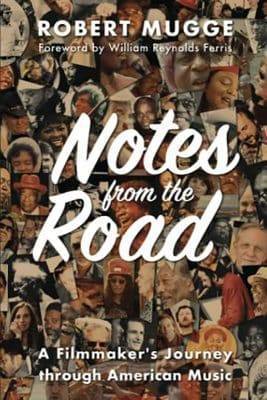Robert Mugge Notes from the Road – A Filmmaker’s Journey through American Music
 Robert Mugge
Robert Mugge
Notes from the Road – A Filmmaker’s Journey through American Music
Sager Group LLC
Readers of these pages have likely seen one, more likely several of the music filmmaker Robert Mugge’s documentary-like music films focused on American roots music and the many branches thereof. Mugge’s films are not documentaries in the narrative and historical sense that we associate with the term. They are centered more on exploration of indigenous music types and the personalities associated with the particular genre of music he presents. Sure, to many it looks easy enough. Hire a small camera crew and some good sound people. Expensive sets are not an issue nor are special effects. However, even novices that have dabbled in film or video editing realize what a painstaking process that can be. Consider also that Mugge and his small teams are working with meager budgets. Okay, we have to resist the notion of describing his films because this is a book, not a film review.
So, why read Notes from the Road, his book about his filmmaking? Some may gain an appreciation of the small budget music film process, but this writer feels that the most fascinating aspects of Mugge’s narratives are the overlooked aspects of the personalities he had to deal with, and the logistical labyrinths he needed to navigate to reach the finish line. Mugge is an excellent writer, so these anecdotes make for an intriguing read, even if one reads only the chapters that relate to the films seen. Mugge has made 36, and details 25 in the book. We will scratch the surface with a few excerpts.
Rather than moving chronologically, he groups them thematically. The comparisons he draws are often especially noteworthy. In his first chapter Mugge groups a film he did with twentieth century West Virginian-born classical composer George Crumb –Voice of the Whale (1976 with his bluegrass film –Gather at the River: A Bluegrass Celebration (1976). Here’s how he draws them together. First. he cites these verses from the title track of the bluegrass film – Shall we gather at the river/The beautiful, beautiful river/Gather with the saints at the river/Thar flows by the throne of God. Then he compares this well-known poem to lyrics sung by local West Virginia church members in the Crumb film and concludes – “In fact, what most connects these two films is their shared focus on nature, time, and spirit, as rooted in the rural mountain culture of both George’s Crumb’s West Virginia and Bill Monroe’s Kentucky. And even George’s evocation of whale songs in ‘Vox Balaene’ resembled the high-pitched, ‘high lonesome’ vocals of bluegrass singers echoing plaintively out of an Appalachian holler. Both suggest a kind of cosmic loneliness and a recurring sense of loss.”
Another area of special interest are the characters he encounters, some the subject of the film such as Sun Ra and others, the hangers-on, who undeservedly beg for a share. Here is Mugge describing an exchange with Sun Ra in an attempt to get the man-from-Saturn to sign a contract that Mugge could show to future investors – “…So, instead, in something between a lecture and a sermon, he spent the next two hours (perhaps less, but it certainly felt that long) explaining to me that he was ‘immortal’ and that, as a result, he could never sign an agreement with someone who would ‘end up in the graveyard.’” As to the hangers-on, here’s an example of a couple trying to ‘run down’ Mugge who grouped four of his six Louisiana-based films in one chapter. This is as vivid a character portrayal as any – “However, as I climbed behind the wheel and started the engine, Maggie and her husband ran up yelling that I had forgotten to pay her. I responded that, all that she had cost me, I had no intention of paying her. Then, as I backed up our vehicle, the two of them grabbed hold of my door, yelling like characters from the old Dukes of Hazzard TV show that they would get me for this. Finally, I dislodged the two of them, yanked my door closed, and screeched away, happy in the knowledge I would never speak to them again…” These are the behind the scenes story that make for riveting reading.
More technical and process fanatics will find those aspects of Mugge’s oft arduous travails of interest. Even more so are Mugge’s stories about dealing with the unexpected. He often used segments in more than one film, His film on Rounder Records, True Believers -The Musical Family of Rounder Records (1994) understandably had to include its biggest star at the time, Alison Krause. She was filmed, as were most in the film, at an outdoor performance in Owensboro that he and his crew thought was great and could be used in the bluegrass and Rounder films. Initial production was complete when Krause informed them that the rain in Owensboro caused her vocals to be less than optimal, thereby refusing to let Mugge use her footage in either film. Consequently she did not appear in a short segment of the entire film aired on TNN but later made amends by recording at the WXPN studios in Philadelphia. Needless to say, events like this are not merely hiccups. They cause havoc with production schedules.
Mugge’s knack for efficiency and maximizing limited budgets at his disposal is also quite revealing. He often tackled multiple projects at once when he was in a specific region like Louisiana with Gather at the River, True Believers, and The Kingdom of Zydeco. Here’s a brief example of handling this juggling act – Together, Scott [Billington] and I planned a brutal schedule for the two main days we would be in the region, and I carefully separated out which of our planned scenes would be shot for the zydeco film, and which would be intended for the Rounder movie. As a result, upon our arrival in Lafayette on Saturday, September 18, we filmed a couple of quick scenes at Festivals Acadiens for the Rounder film. Then, he and I raced a few of my crew members to numerous other zydeco-related locations while the rest of my crew set up for the Steve Riley show that night in Eunice. Even for one film, specifically Rhythm ’N’ Bayous the logistics would make one weary just reading it,, “…I built the following itinerary. A major shoot in Shreveport on Monday, several smaller shoots in Monroe and Winnsboro on Tuesday, a major shoot in Baton Rouge on Wednesday, a small shoot in New Orleans Thursday afternoon, and a bigger one with the Rock (and Roll HOF) in attendance that evening, a major shoot in Lafayette on Friday evening,…smaller shoots in Ville Platt and Mamou on Saturday, and a major, all-day shoot in Lafayette on Sunday, which would close out our production schedule.”
Yet, beyond these details which certainly suggest incredible drive, resilience, and resourcefulness, the overriding takeaway from the book is Mugge’s genuine love for the music and all the cultural aspects that surround it such as food, local customs, and legends. To call him an American treasure is not an overstatement as no one else has delved into the music this way. His passion is consistently palpable through the various genres he covers. In his postscript he says – “For me, true documentary filmmaking involves exactly what the words imply, documentation, out in the world, while history is still being made—and in the best cases, spirit-catching, which does not happen in an editing room alone. As much as anything, my films are about the remarkable spirits my crew and I have ‘captured’ in their natural (musical) habitats.” For more on Robert Mugge and a definitive list of his films, visit http:/www.robertmugge.com Suggest you watch before reading or do it side by side in sections. You’ll have a much better context. Enjoy both the films and his book.
- Jim Hynes
Al Green performs “People Get Ready” in Robert Mugge’s GOSPEL ACCORDING TO AL GREEN from Robert Mugge on Vimeo.
Morgan Freeman and Irma Thomas in Robert Mugge’s BLUES DIVAS from Robert Mugge on Vimeo.
Buy Us a Cup of Coffee!
Join the movement in supporting Making a Scene, the premier independent resource for both emerging musicians and the dedicated fans who champion them.
We showcase this vibrant community that celebrates the raw talent and creative spirit driving the music industry forward. From insightful articles and in-depth interviews to exclusive content and insider tips, Making a Scene empowers artists to thrive and fans to discover their next favorite sound.
Together, let’s amplify the voices of independent musicians and forge unforgettable connections through the power of music
Make a one-time donation
Make a monthly donation
Make a yearly donation
Buy us a cup of Coffee!
Or enter a custom amount
Your contribution is appreciated.
Your contribution is appreciated.
Your contribution is appreciated.
DonateDonate monthlyDonate yearlyYou can donate directly through Paypal!
Subscribe to Our Newsletter
Discover more from Making A Scene!
Subscribe to get the latest posts sent to your email.












































